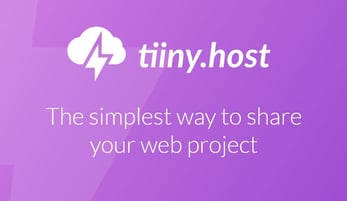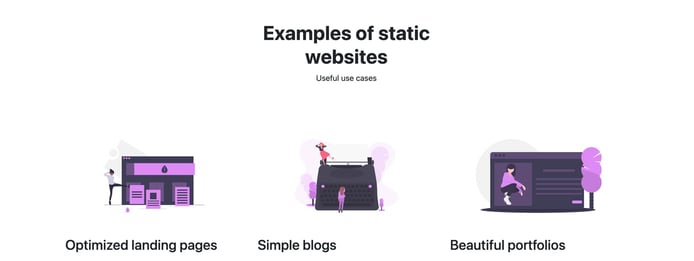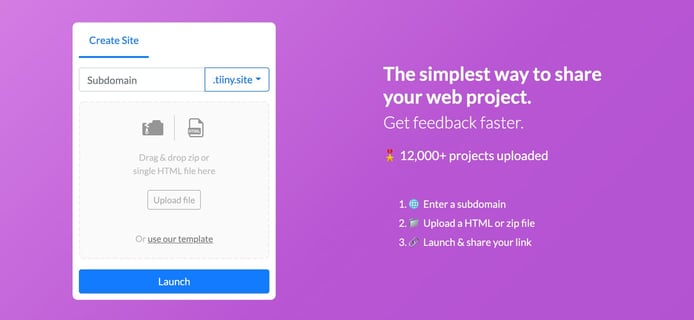
TL; DR: The early approach to web development was to deploy static sites driven by HTML pages. That strategy still offers a compelling use case despite the advent of the dynamic web. Tiiny Host, a provider of hosted static sites, delivers free temporary and more permanent paid solutions with enhancements including a CDN and SSL certificates. The company also partners with student developers to help grow their knowledge and vision. Its upcoming road map includes the integration of an HTML forms processor, and the company has just launched an on-site page editing tool.
Web hosting, in its simplest form, is just a server delivering an HTML file and its associated assets to a connected remote browser. Modern websites tend to be complex affairs, leveraging technologies including cascading style sheets, PHP and ASP scripts, and Javascript frameworks to produce immersive, responsive user experiences.
At the heart of all that coding lies the HTML page, and sometimes simplicity is the best option for a given technical purpose.
“I came up with the idea to enable hosting for a lot more people,” said Philip Baretto, Founder of Tiiny Host, a platform that makes the web more accessible. “We abstract away a lot of the complexities of hosting and take it to a simple drag-and-drop workflow. Clients focus mainly on developing and learning how to code their first website, or craft a prototype they want to get live in just a few seconds.”

Tiiny Host offers entrepreneurs a simple way to get website prototypes up and running quickly.
Tiiny Host users select a subdomain on tiiny.site then upload an HTML file or a ZIP archive containing a collection of HTML files — no scripts. Then, they press the launch button and, within a second or two, the site is live at the specified URL. The process requires a validated email address when uploading content to reduce spam and abuse, although Tiiny Host automatically deletes them after one week, and there’s a 3MB total upload size limit.
TiinyHost also allows users to use any custom subdomain they want, which is not common among other providers. This allows users to upload content to memorable URLs rather than randomly generated URLs, providing an even simpler hosting experience.
The company also offers a paid pro account that supports five live and seven archived sites using custom domain names. Those have a 50MB upload limit for ZIPs, password protection, custom SSL certificates, a CDN, and the removal of Tiiny Host branding. The service includes discounts for students.
“For people who just want something super simple and easy to use, they don’t need to understand Git, and they don’t need to configure cPanel,” Philip said. “They just need to worry about developing their website and putting it up and getting instant feedback.”
Static Hosting Reduces Complexity and Increases Speed
In the earliest days of the web, script-driven sites like WordPress, Joomla, or visual designer tools like Wix didn’t exist. Given generally poor dial-up connections, the priority was speed, which meant that the early web was text-driven, with images — typically highly compressed — used sparingly. Site design often went through a text editor, with developers hand-coding their own HTML and manually configuring site assets.
Those sites are called static because the content doesn’t change dynamically based on user interaction or database records.
As the web matured, new technologies entered the mix, including cascading style sheets and proprietary frameworks like Cold Fusion or FrontPage. Later, complex content management systems like WordPress and Joomla appeared, running on PHP with full database connectivity. Bandwidth concerns, which were so pressing in the late 1990s, also declined, freeing designers to incorporate more graphical and video elements.

Static websites offer compelling visuals without the clutter and resources of dynamic pages.
By the mid-2010s, the web had largely settled, at least in terms of its technology stack.
It’s a mistake, though, to assume that static web pages are outdated technology. Strictly speaking, all web pages are static. Various scripts and apps do the heavy lifting of supplying dynamic content or changing how the HTML renders. The benefits of a static site comes down to speed, security, and deployability.
A static site is almost always faster, on the speed and security front, because it doesn’t have to wait for other servers or applications to return data. Because static sites lack interaction with server-side libraries or database connections, it’s rare for security risks to arise.
On the deployability side, a static site does not depend on scripting frameworks like PHP or ASP. Nor does it require database connections. A static site is self-contained without a dev configuring and managing external supporting applications or API links.
When someone uploads HTML, it displays automatically in a browser. There are no special firewall ports to open, web-server settings to tweak, or mandatory database credentials required.
Non-Dynamic Websites Fill a Vital Niche in the Open Web
Static websites fill several use cases. For businesses, a quick static site proves useful for small businesses and short-term testing and advertising.
“We’ve had small businesses, including restaurants, hosting their landing pages,” Philip said. “We’ve had agencies use them to test ads and email templates, and real estate people use it to upload 360-degree tours of various apartments.”
Businesses also use Tiiny Host for site backups or as a reroute destination if their primary website goes down. For example, a complex scripted site requiring downtime maintenance can redirect to a Tiiny Host page that may not offer rich, interactive complexity but is still better than returning browser errors to potential customers. And since static sites don’t host consumer data, they’re inherently compliant with international data regulations, including GDPR and the CCPA.
Students find value with Tiiny Host’s service, too.

Tiiny Host helps students, small businesses, and job seekers get their ideas online.
“We had a professor in Brazil reach out to us a few months ago who teaches a Udemy course on hosting. He uses us to teach people, and they’re impressed at how quickly they can create a webpage and get it out on the web,” Philip said. “They don’t necessarily want to learn the complexities of dynamic sites. They’re just learning HTML for the first time. It takes me back to the first time I built a website — that feeling of having something out there, like an online presence.”
Static sites also work well for prototypes. Even if a web developer works on a dynamic site, it’s often easier to mock up several versions of a static site to help clients choose among layouts and visual styles. A simple static placeholder gets the job done without forcing the developer to code several variations of the final site.
Many bloggers have also rediscovered the joys of the static web. The power and customizability of WordPress, for example, is beneficial, but a static site gets the job done, too. Several up-and-coming blog management systems, including Siteleaf, are optimized for static frameworks. And tools like GitHub Pages make it easy for tech-savvy bloggers to write text files to a GitHub repository then compile the resulting text to a static blog, unmediated by complex plugins or PHP-dependent management interfaces.
Tiiny Host: Fast, Simple Sites and Robust Customer Support
Web technology is far more advanced than it was in the 1990s. However, even though most of the Web uses script-heavy content management platforms, the original static standard still works well. It even offers several significant advantages over more modern, complex alternatives.
Static websites are fast, secure, and easy to deploy. They fill a vital role in helping businesses maintain online continuity in case of site errors or maintenance. Agencies and developers can use a series of easy-to-tweak static sites to prototype more complex solutions for customers. They can also help students learn the basics of web development and HTML scripting.
Tiiny Host values its small team, which leads to more personal interaction with customers. Those include conversations outside the scope of most tech-support challenges.
“I think the support is very personal,” Philip said. “And people are surprised that we don’t have a ticketing system. We are relatively small, so if you send us an email or you message us via chat, we’ll reply to you straight away.”
The support team even helps students troubleshoot basic HTML coding errors.
Tiiny Host is also launching two significant service enhancements. It’s most recent update includes an on-site page editing tool, which allows editing of its hosted web pages online instead of re-uploading modifications. Second, the company will integrate a form tool into the hosting system.
“The majority of websites don’t allow anything dynamic other than forms,” Philip said. “So we are building a system to allow you to easily integrate forms into your web page.”
Tiiny Host delivers rapid static hosting at little or no cost that fills several essential use cases. According to Philip, the value proposition is clear.
“If you want to get something up and running in a few seconds for trial or prototype, work with us to use it for a more permanent solution as well. We’ve got a lot to offer for such a straightforward service,” Philip said.
HostingAdvice.com is a free online resource that offers valuable content and comparison services to users. To keep this resource 100% free, we receive compensation from many of the offers listed on the site. Along with key review factors, this compensation may impact how and where products appear across the site (including, for example, the order in which they appear). HostingAdvice.com does not include the entire universe of available offers. Editorial opinions expressed on the site are strictly our own and are not provided, endorsed, or approved by advertisers.
Our site is committed to publishing independent, accurate content guided by strict editorial guidelines. Before articles and reviews are published on our site, they undergo a thorough review process performed by a team of independent editors and subject-matter experts to ensure the content’s accuracy, timeliness, and impartiality. Our editorial team is separate and independent of our site’s advertisers, and the opinions they express on our site are their own. To read more about our team members and their editorial backgrounds, please visit our site’s About page.



